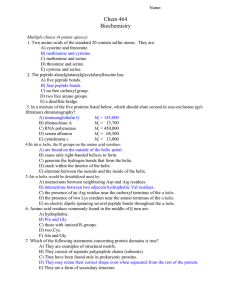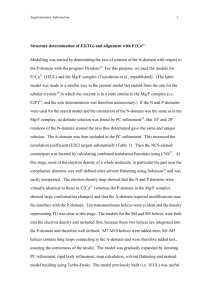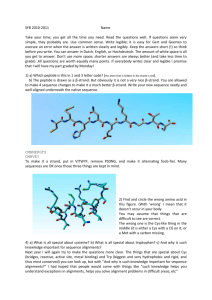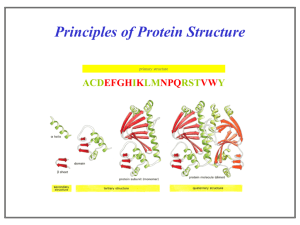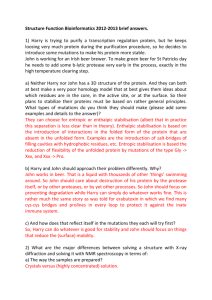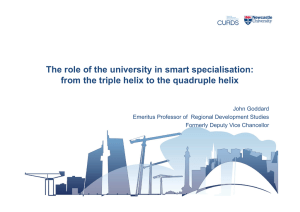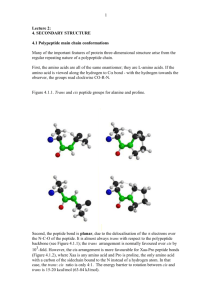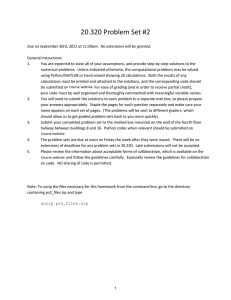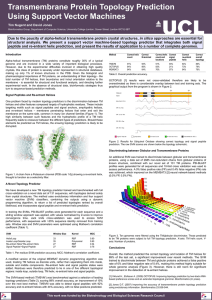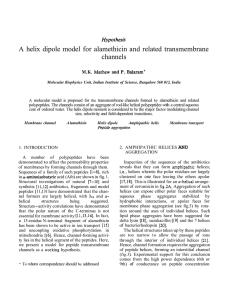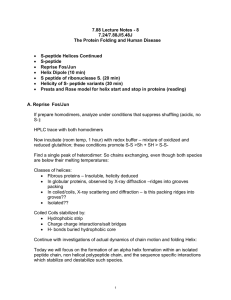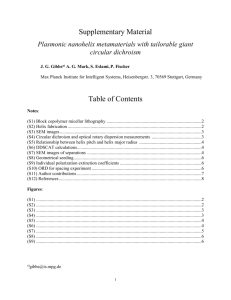Lecture 3
advertisement
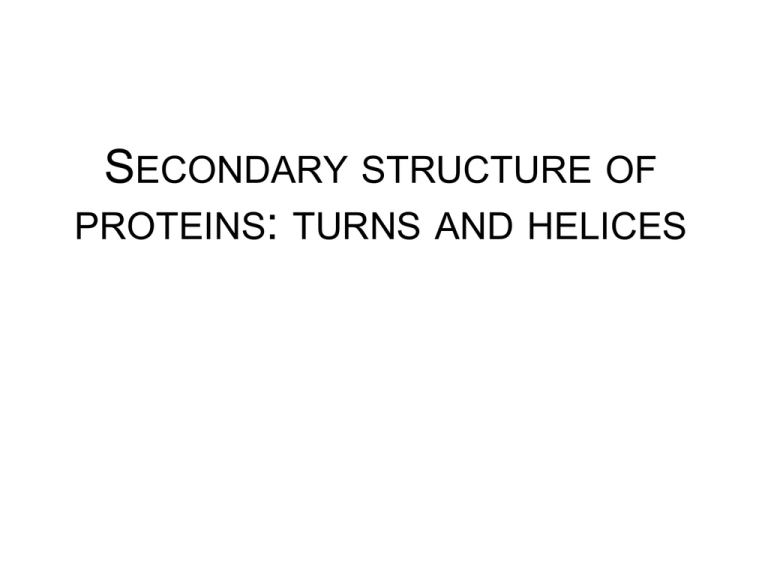
SECONDARY STRUCTURE OF PROTEINS: TURNS AND HELICES Levels of protein structure organization Peptide bond geometry Hybrid of two canonical structures 60% 40% Electronic structure of peptide bond Peptide bond: planarity The partially double character of the peptide bond results in •planarity of peptide groups •their relatively large dipole moment Side chain conformations: the c angles c1 c 2 c 3 c1=0 Dihedrals with which to describe polypeptide geometry side chain main chain Peptide group: cis-trans isomerization Skan z wykresem energii Because of peptide group planarity, main chain conformation is effectively defined by the f and y angles. Side chain conformations The dihedral angles with which to describe the geometry of disulfide bridges Some f and y pairs are not allowed due to steric overlap (e.g, f=y=0o) The Ramachandran map Conformations of a terminally-blocked amino-acid residue E Zimmerman, Pottle, Nemethy, Scheraga, Macromolecules, 10, 1-9 (1977) C7eq C7ax Energy maps of Ac-Ala-NHMe and Ac-Gly-AHMe obtained with the ECEPP/2 force field Energy curve of Ac-Pro-NHMe obtained with the ECEPP/2 force field fL-Pro-68o Energy minima of therminally-blocked alanine with the ECEPP/2 force field Elements of protein secondary structure • • • • • Turns (local) Loops (local) Helices (periodic) Sheets (periodic) Statistical coil (not regular) g- and b-turns g-turn (fi+1=-79o, yi+1=69o) b-turns Types of b-turns in proteins Hutchinson and Thornton, Protein Sci., 3, 2207-2216 (1994) Older classification Lewis, Momany, Scheraga, Biochim. Biophys. Acta, 303, 211-229 (1973) fi+1=-60o, yi+1=-30o, fi+2=-90o, yi+2=0o fi+1=-60o, yi+1=-30o, fi+2=-60o, yi+2=-30o fi+1=60o, yi+1=30o, fi+2=90o, yi+2=0o fi+1=60o, yi+1=30o, fi+2=60o, yi+2=30o fi+1=-60o, yi+1=120o, fi+2=80o, yi+1=0o fi+1=60o, yi+1=-120o, fi+2=-80o, yi+1=0o fi+1=-80o, yi+1=80o, fi+2=80o, yi+2=-80o cis-proline |yi+1|80o, |fi+2|<60o |yi+1|60o, |fi+2|180o Helical structures a-helical structure predicted by L. Pauling; the name was given after classification of X-ray diagrams. Helices do have handedness. Geometrical parameters of helices Average parameters of helical structures Type H-bond Turns closed by Hbond radius Idealized hydrogen-bonded helical structures: 310-helix (left), a-helix (middle), p-helix (right) a-helices: deformations bifurcated or mismatched H-bonds disrupt periodic structure Bifurcated hydrogen bonds (1,4 and 1,5) at helix ends. 1,3-, and 1,4-hydrogen 1,6-hydrogen bonds at helix ends. bonds at helix ends. Zniekształcenia a-helis dodatkowe wiązania wodorowe na końcach helis (wiązanie wodorowe rozwidlone lub zmiana wiązania wodorowego) Bifurcated hydrogen bonds (1,4 and 1,5) at the N-terminums of helix A of thermolysin. Bifurcated hydrogen bonds (1,4 and 1,5) at the C-terminums of helix D of carboxypeptidase. 1,6 and 2,5 hydrogen bonds at the C-terminus of helix A in lysosyme Helix deformation (kink) Example from myoglobin structure. The kink angle is up to 20o Additional H-bonds with water molecules Other factors resulting in helix deformation 1. Deformation is forced because of tertiary structure (crowding). 2. Strong H-bonding (e.g., between side chains). 3. Helix breakers inside; Pro will result in a kink for sure and Gly almost always but small polar amino acids such as Ser and Thr also can. Kink inside an a-helix in phosphoglyceryl aldehyde dehydrogenase Helix breaking by Pro residues Ring constraint No amide hydrogen O C-O N H Helix capping The first and Izolowana 12-resztowa the last residue a-helisa are the posiada capping 12 grup residues donorowych NH oraz 12 grup akceptorowych CO wiązania wodorowego (w obrębie łańcucha głównego). W 12 The N1 and C1 residues possess f and y angle values typical of an a-helix resztowej helisie może utworzyć się tylko 8 wewnątrzcząsteczkowych wiązań wodorowych. About 48% residues N- i C-Końcowy in Ncap-N1-N2-N3 fragmentfragments helisy zawiera and about więc35% 4 wolne of residues donory in NH -C3-C2i4 wolnecapC1-C akceptory fragments COforms wiązań hydrogen wodorowych. bonds in Kompensacją which side-chain tej niedogodności groups take part. jest występowanie polarnych reszt aa na N- i C-końcu helisy. N- i C-Końcowe fragmenty helis wykazują dodatkowo różne preferencje co do określonych reszt aa. ...-N’’-N’-Ncap-N1-N2-N3-...........................-C3-C2-C1-Ccap-C’-C’’-... Residue preferences to occur at end or close-to-end positions a-helices always have a large dipole moment Side chain arrangement in helices Contact interactions occur between the side chains separated by 3 residues in amino-acid sequence Schematic representation a-helices: helical wheel 3.6 residues per turn = a residue every 100o. Examples of helical wheels Amphipatic (or amphiphilic) helices One side contains hydrophobic aminoacids, the other one hydrophilic ones. In globular proteins, the hydrophilic side is exposed to the solvent and the hydrophobic side is packed against the inside of the globule Hydrophobic Hydrophilic Amphipatic helices often interact with lipid membranes hydrophilic head group aliphatic carbon chain lipid bilayer download cytochrome B562 Length of a-helices in proteins 10-17 amino acids on average (3-5 turns); however much longer helices occur in muscle proteins (myosin, actin) Proline helices (without H-bonds) Polyproline helices I, II, and III (PI, PII, and PIII): contain proline and glycine residues and are left-handed. PII is the building block of collagen; has also been postulated as the conformation of polypeptide chains at initial folding stages. Polyproline ring conformations C2 (half-chair) conformations of Cg-endo L-proline CS (envelope) conformation of Cg-endo L-proline peptide group at the trans position with respect to Ca-H (Y=120o), as in collagene CS (envelope) of Cg-egzo L-proline with the peptide group at the cis’ orientation with respect to Ca-H (Y=-60o) f and y angles of regular and polyproline helices Structure F Y w a-helix -57 -47 180 +3.6 1.5 310-helix -49 -26 180 +3.0 2.0 p-helix -57 -70 180 +4.4 1.15 Polyproline I -83 +158 0 +3.33 1.9 Polyproline II -78 +149 180 -3.0 3.12 Polyproline III -80 +150 180 +3.0 3.1 residues/turn turns/residue Deca-glycine in PPII and PPI without hydrogen atoms, spacefill modells, CPK colouring PPI-PRO.PDB PPII-PRO.PDB Poly-L-proline in PPII conformation, viewed parallel to the helix axis, presented as sticks, without H-atoms. (PDB) It can be seen, that the PPII helix has a 3-fold symmetry, and every 4th residue is in the same position (at a distance of 9.3 Å from each other). The b-helix
